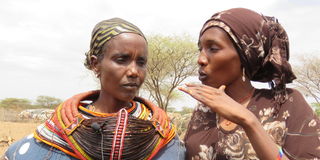Rural women work to save dying Rendille language

A youth Anneta Bagajoengages Ms Dahato Esimruso outside her manyatta at Loglogo Township in Marsabit County on July 26,2022. Nearly all the youths in Laisamis and Loglogo Wards cannot speak their native Rendile language having been assimilated to the Samburu community..
They are women with a mission – to preserve their ancestral language from extinction.
Though the Rendille language is yet to find its way to the list of threatened dialects in the world, the elderly in this part of Marsabit County have a reason to worry.
“Only those aged 40 and above can speak the language fluently. Others only understand the language of our neighbours, the Samburu,” says Ms Sistai Segelem, from Laisamis sub-county.
Some of the Kenyan languages classified as endangered by the United Nations cultural agency Unesco include Terik, El molo, Ogiek, Omotik, Bong’om, Sogoo, Suba and Yakunte.
Rendille language
Over the years, the Rendille language has been dying slowly and the community in Loglogo and Laisamis wards is now determined to persuade youngsters to learn and preserve their cultural identity.
Incidentally, the Rendille are Cushites believed to be related to the Somali community. The fine facial features and language of the two communities bear great resemblance.
Though most of the Rendille community are Christians, their dressing code resembles that of Muslims, notably among women, who wear long dresses and a headscarf (hijab) that covers their hair, neck and shoulders.
But save for their way of dressing, they have over the years found themselves assimilated to the culture and traditions of the Nilotic Samburu community and mainly on the language, creating the impression of people with a triple identity – Rendille, Somali and Samburu.
Most of the adults in this pastoralist community speak both Rendille and Samburu, but they are still holding on to hope that future generations will not be swayed into copying the cultural and lifestyles of their neighbours and abandon their traditions.
“It is only in Korr and Kargi locations where you will find people speaking pure Rendille. But in other areas occupied by our people in Marsabit County, Samburu is the language of choice,” says 55-year-old Mete Lekalmogule.

Ms Sistai Segelan, the treasurer of Merigo Cultural Centre which launched a programme to teach youth and children the Rendile language on July 26, 2022.
Ms Lekalmogule explains that those who end up getting married to Loglogo ward from Korr or Kargi must learn the Samburu language and their children end up abandoning their mother tongue altogether.
In an effort to preserve their traditions, Ms Segelan and 24 other women founded the Merigo Cultural Centre in Loglogo town. One of the objectives of this group was to teach children the language of their forefathers.
“Members of our group contributed and we could hire qualified teachers to come and teach our children the Rendille language. Young adults could come in the afternoon while children attended evening lessons after school,” says Ms Segelan.
This project ran for two years before it was halted three years ago owing to financial constraints.
“We did not have any support and we contributed from our pockets to pay the two teachers. Eventually, the teachers left to look for better opportunities in conventional schools where they were assured of regular pay,” explains the treasurer of the group.
Eco-tourism cottages
Besides the language school, the women have also constructed eco-tourism cottages for guests, a conference hall and a cultural display room for those interested in learning about the rich traditions of this community.
Ms Segelan says one of the reasons that contributed to the closure of the language teaching project was reduced income from the eco-tourism lodge following the Covid-19 pandemic. Perennial insecurity has also affected the business, with a dusk-to-dawn curfew now in force in the entire Marsabit County.
“Once our business improves in the coming days, we shall roll out the language project again since we believe it is necessary. We are proud that the youths attending the classes can now speak our language and we aim to net more people in future,” says the official.
A recent survey carried out by the Pastoralist People’s Initiative (PPI), a local community-based organisation, established that 40 percent of the Rendille people cannot speak their ancestral language fluently.
“We need to do some interventions before it is too late. You notice that we are also facing the challenges of westernisation where our children prefer speaking either English or Kiswahili,” argues Ms Margaret Super, PPI executive director.

A youth Anneta Bagajoengages Ms Dahato Esimruso outside her manyatta at Loglogo Township in Marsabit County on July 26,2022. Nearly all the youths in Laisamis and Loglogo Wards cannot speak their native Rendile language having been assimilated to the Samburu community..
“If we choose to do nothing, our culture and language will be completely eroded in a few decades to come.”
Ms Super says that though she can speak Rendille fluently, her two children only understand the Samburu language.
“I had enrolled one of my sons at the Merigo Cultural Centre’s language school, but the project ended before he could make any progress,” she says.
Ms Dahato Esimruso, another resident, appealed to the Marsabit County government to help protect the language.
“I am originally from Korr, but when I got married here, I had no choice but to learn the language spoken here,” Ms Esimruso says.
“Out of my seven children, only the firstborn understands the Rendille language, the others speak Samburu. We should never allow our language to die when something can be done to stop it.”





